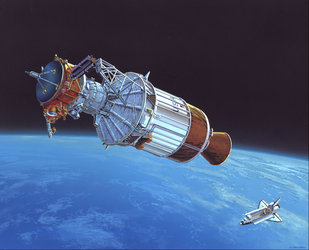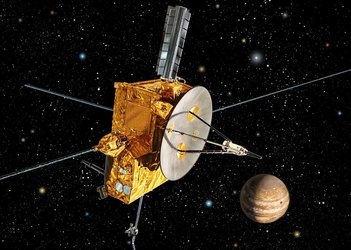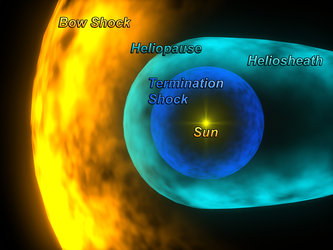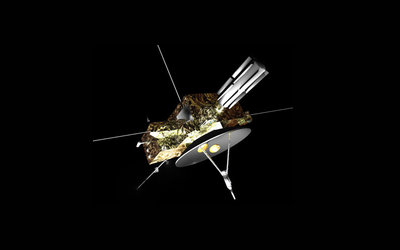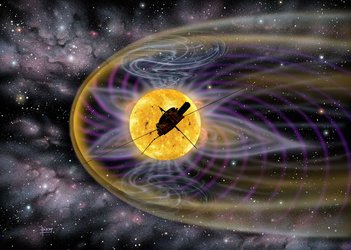Ulysses science highlights
Charting the poles of the Sun
Ulysses, a joint ESA/NASA mission, was launched aboard the Space Shuttle on 6 October 1990 from Kennedy Space Center in Florida, heading for an unprecedented journey of discovery. It was the first mission to study the unknown environment of space above and below the poles of the Sun.
With Ulysses, scientists obtained the first-ever four-dimensional map of the heliosphere – the bubble generated by the solar wind that defines the sphere of influence of the Sun.
Originally designed for a lifetime of five years, the mission surpassed all expectations. The reams of data returned by Ulysses have forever changed the way scientists view the Sun and its effect on the space surrounding it.
Science objectives
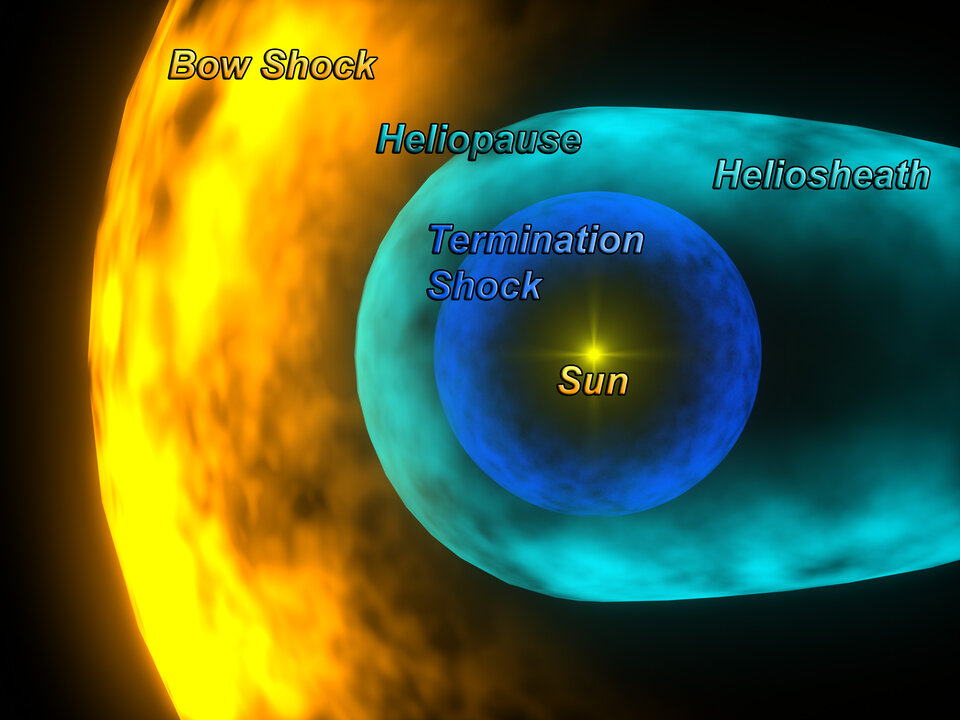
- to determine the solar wind’s global properties and behaviour in three dimensions, to study its origin by measuring its composition at different solar latitudes, and to learn more about waves and shocks by sampling solar wind conditions at all latitudes
- to study how energetic particles of solar and interplanetary origin move and are accelerated by observing their properties at all latitudes
- to study the magnetic field of the Sun and of the heliosphere
- to study galactic cosmic rays – mainly protons and electrons with high energies – and to learn more about their origin
- to learn more about how the heliosphere interacts with interstellar space, and to improve our understanding of interplanetary and interstellar gas and dust
- to look for gamma-ray burst sources and, in combination with observations from other spacecraft, help identify them with known celestial objects.
Thanks to its suite of instruments and its special orbit around the Sun, in addition to the long duration of its mission – a major achievement on its own – the key discoveries of Ulysses range from the best-ever understanding of the heliosphere and the role played by its magnetic field in all the phenomena occurring inside it, to important astrophysical questions such as the evolution of the Universe.
Key discoveries
- Nature and behaviour of the heliosphere’s magnetic field. Ulysses has found that the heliospheric magnetic field, which originates from the Sun’s magnetic field, is both more complicated and at the same time simpler than previously thought. It is more complicated because its field lines do not follow an ordered spiral but a more chaotic pattern and spread more in latitude than initially believed. It is simpler because the Sun’s magnetic dipole – similar to a bar magnet – simply rotates by 180° to accomplish the known reversal in polarity. Besides, at distances beyond three to five times the radius of the Sun, the outward (radial) component has the same strength at all latitudes.
- The solar wind in four dimensions. Ulysses found that, at solar minimum, the wind from the cooler regions close to the Sun’s poles fans out to fill two thirds of the heliosphere, and blows at a uniform speed of 750 km/s (fast wind), much faster than the wind that emerges from the Sun’s equatorial zone at 350 km/s. Ulysses also studied the origin of the wind in the solar corona, the nature of the magnetic field it carries away from the Sun, and its interaction with the interstellar gas and plasma that surrounds the heliosphere.
- Energetic particles climb up to the Sun’s poles. Ulysses has revealed that previous ideas on how charged energetic particles are transported in the heliosphere need thorough revision. Since the Sun’s magnetic field lines, which drive the flow of charged particles, are more chaotic and can undergo big excursions in latitude, such particles can also be found over the poles even at solar minimum, far away from the solar storms that originated them. This is important, as astronauts in deep space may be exposed to radiation from sources previously considered ‘safe’.
- No easier access to the heliosphere for cosmic rays. Ulysses found that at solar minimum, cosmic rays from within our galaxy do not have – as previously believed – any easier access to the heliosphere at the polar regions where the magnetic field was thought to be weaker and more radial. On the contrary, their distribution is almost spherically symmetric. This is the result of waves propagating along magnetic field lines in the fast solar wind that oppose this access.
- ‘Titanic shock’ between the heliosphere and interstellar gas. The nature of the interstellar cloud of dust and gas that the Solar System crosses and the size of the heliosphere can now be better understood thanks to Ulysses’s measurements of interstellar helium that penetrates the heliosphere itself. Ulysses also found that interstellar wind is fast enough to create a shockwave where the heliosphere’s outer fringes meet interstellar gas, affecting the access of the gas itself.
- Interstellar dust can enter the heliosphere. For the first time, Ulysses detected tiny dust particles of interstellar origin, proving that they can enter the heliosphere.
- Lifetime of galactic cosmic rays. Ulysses has studied the abundance of many radioactive cosmic rays (produced when cosmic rays collide with atoms of interstellar gas and lose neutrons or protons, leaving behind radioactive species); only two kinds were measured prior to Ulysses. It showed that they spend most of their lifetimes of 10–20 million years in the galactic halo (the area above and below our galaxy’s disc where the amount of matter is significantly lower) before they reach us.
- Will the Universe collapse in the end? Ulysses measured the abundances of helium isotopes in interstellar gas for the first time. These measurements, which are important for studies of the Big Bang, support the theory by which the amount of matter in the Universe is not enough to lead to a final cosmic collapse at the end of time.
Instruments
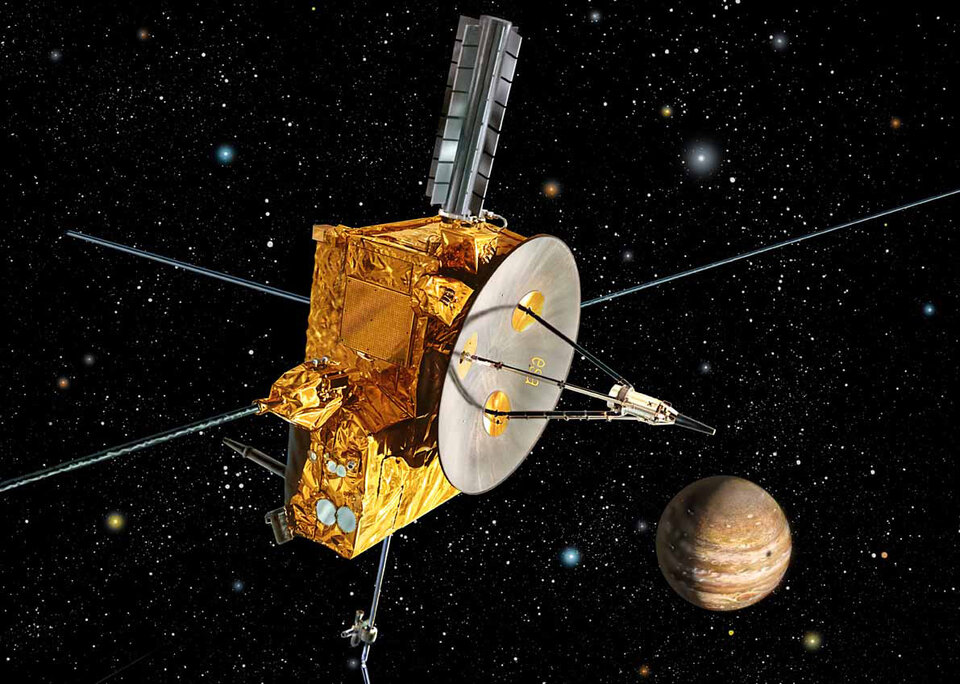
The 10 science instruments on board Ulysses consisted of an array of sophisticated sensors for gauging the invisible wind, ions and electrons, dust grains and gas, magnetic fields, radio and plasma waves, X-rays, and gamma-rays that permeate the space around the Sun. These were:
Magnetometer (MAG): MAG performed measurements of the magnetic field in the heliosphere and studied how it varies at different heliospheric latitudes. Measurements of Jupiter’s magnetic field were also performed.
Solar Wind Plasma Experiment (SWOOPS): The SWOOPS experiment studied the solar wind at all solar distances and latitudes and in three dimensions.
Solar Wind Ion Composition Instrument (SWICS): SWICS determined the composition, temperature and speed of the atoms and ions that comprise the solar wind.
Unified Radio and Plasma Wave Instrument (URAP): URAP studied radio waves from the Sun and electromagnetic waves generated in the solar wind close to the spacecraft.
Energetic Particle Instrument (EPAC) and GAS: EPAC investigated the energy, fluxes and distribution of energetic particles in the heliosphere, while GAS studied the electrically-uncharged gas (helium) of interstellar origin.
Low-Energy Ion and Electron Experiment (HI-SCALE): HI-SCALE investigated the energy, fluxes and distribution of energetic particles in the heliosphere.
Cosmic Ray and Solar Particle Instrument (COSPIN): COSPIN investigated the energy, fluxes and distribution of energetic particles and galactic cosmic rays in the heliosphere.
Solar X-ray and Cosmic Gamma-Ray Burst Instrument (GRB): GRB has been studied cosmic gammaray bursts and X-rays from solar flares.
Dust Experiment (DUST): DUST carried out direct measurements of interplanetary and interstellar dust grains to investigate their properties as functions of the distance from the Sun and solar latitude.
For more information, see this ESA/NASA factsheet last updated in 2008.





